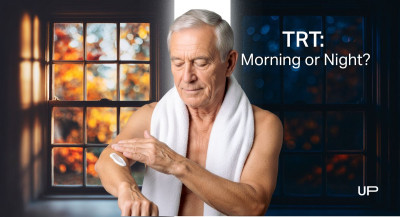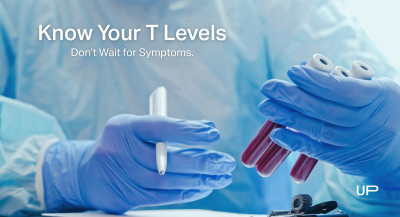TRT & Hair Loss: What The Science Really Says About Balding And Hair Growth


Many men over 40 start testosterone replacement therapy (TRT) in Canada to feel more energetic, stronger, and healthier, but one question comes up almost immediately: Will TRT affect my hair? With so much mixed information online, it can be hard to know whether testosterone leads to hair loss, helps with hair growth, or has no direct effect at all.

In reality, the connection between testosterone, DHT, and hair follicles is more complex than most people think. Genetics, hormone balance, and underlying health all play bigger roles than TRT alone, and the science shows very different outcomes depending on your starting point.
This guide breaks down the research in a clear and simple way, helping Canadian men understand what actually happens to their hair during TRT and what they can do to protect or improve it.
Topics covered in this article:
Key Takeaways (1-Minute Summary)
- TRT does not directly cause hair loss for most men. Genetics and DHT sensitivity are the primary factors.
- Some men may notice temporary shedding when hormone levels first adjust, but this usually stabilizes.
- Low testosterone can contribute to weak, thinning, or slow-growing hair, so balanced levels may improve overall hair quality.
- TRT can increase DHT in some individuals, which may accelerate male pattern baldness only if they are genetically prone to it.
- Men who want to protect their hair can combine TRT with treatments like finasteride, minoxidil, or ketoconazole after speaking with a healthcare provider.
- Understanding your personal risk factors helps you make informed choices about TRT and long-term hair health in Canada.

Does TRT Cause Hair Loss? The Science Explained
Many men starting TRT worry that boosting testosterone will automatically lead to hair loss. The truth is more layered. Understanding how hormones interact with your hair follicles helps clarify what really happens once testosterone levels rise.
How testosterone converts to DHT
Testosterone naturally converts into a hormone called DHT through an enzyme called 5-alpha reductase. DHT is the same hormone responsible for male pattern baldness in genetically sensitive men. TRT can increase both testosterone and DHT in some individuals, but the effect varies widely.
In short, the conversion to DHT is normal and expected, but how your follicles respond depends on your biology.
Why genetics matter more than TRT
Hair loss does not start with TRT. It starts with genetics. If your hair follicles are sensitive to DHT because of family history, thinning may happen whether you use TRT or not. If you are not genetically predisposed, higher testosterone or DHT levels often make no difference at all.
This is why two men can take the same TRT dose and have completely different hair outcomes.
When TRT might trigger shedding
Some men experience temporary shedding when hormone levels shift quickly at the start of therapy. This happens as the body adjusts to new hormone levels and is usually a short-lived phase.
Shedding does not always equal permanent hair loss. In many cases, the hair cycle resets and stabilizes.
When TRT has no impact at all
For many men, TRT does not lead to more hair loss because their follicles are not sensitive to DHT. Others may even notice better hair quality if low testosterone was contributing to weak or thinning strands before treatment.
Ultimately, TRT only affects hair if your genetics and follicle sensitivity make you more vulnerable.
Can TRT Help With Hair Growth?
Although many men worry about hair loss on TRT, the science shows that properly balanced hormones can actually support healthier hair under the right conditions. It depends on why the hair was thinning in the first place and how low testosterone affected the body before treatment.
When stabilizing testosterone improves hair quality
Some men notice that once their testosterone levels reach a healthy range, their hair looks thicker or healthier. Stable hormone levels help regulate the hair growth cycle and support stronger strands. Men who were dealing with hormonal fluctuations before TRT sometimes see improvement simply because their hormones stop swinging up and down.
Low T and the link to weak or thinning hair
Low testosterone can contribute to hair that feels weak, brittle, or slow growing. It may also impact circulation, nutrient delivery, and overall follicle function. TRT can correct these underlying issues for some men, which may help hair grow in more consistently or look fuller.
How improved energy, sleep, and metabolism support healthier hair indirectly
When testosterone levels rise to a balanced range, overall health improves. Better sleep, higher energy, healthier metabolism, and more stable mood all support a stronger hair growth environment. Hair responds best when the body is functioning well, and TRT can be part of that picture.
In the end, TRT does not directly regrow hair, but it can create better conditions for healthy growth, especially in men whose low T contributed to poor hair quality.
TRT, DHT and Male Pattern Baldness
Male pattern baldness is one of the most common concerns for men starting TRT, especially if hair loss has already begun. Understanding how DHT interacts with hair follicles helps clarify what TRT can and cannot influence.
Clear yes and no scenarios
Yes, TRT may contribute to more hair loss if:
- You already have male pattern baldness
- Your follicles are genetically sensitive to DHT
- Your DHT levels increase significantly on TRT
- You have thinning at the temples or crown before treatment
- Your family history shows early or rapid balding
No, TRT does not cause hair loss if:
- You are not genetically prone to male pattern baldness
- Your follicles have low sensitivity to DHT
- Your DHT does not rise dramatically on TRT
- You have stable, full hair before treatment
- Balding does not run in your family
What actually drives MPB
Male pattern baldness is driven by genetics. Hair follicles that react strongly to DHT gradually shrink, producing thinner and shorter strands over time. This process continues whether or not a man is on TRT, and it starts long before symptoms become visible. TRT may speed up what was already happening, but it does not create MPB in someone who is not genetically predisposed.
Why DHT blockers change the outcome
Medications like finasteride reduce the amount of testosterone that converts into DHT. Lowering DHT can slow down shedding, protect vulnerable follicles, and help preserve existing hair. Many men on TRT who want to protect their hair use a DHT blocker as part of a combined treatment plan after consulting with a healthcare provider.
In the end, DHT is the key driver of male pattern baldness, and TRT only plays a role when genetics and follicle sensitivity are already in place.

How Men on TRT Can Protect Their Hair
If you are starting TRT and want to keep your hair healthy, there are proven options that can help minimize shedding and support stronger growth. These treatments target the main causes of hair loss and can be used individually or together, depending on your needs.
Effective options include:
- Finasteride to reduce DHT levels
- Topical minoxidil to stimulate follicles and increase growth
- Oral minoxidil for men who want a stronger growth effect
- Ketoconazole shampoo to reduce inflammation and DHT at the scalp level
When to intervene
It is often best to take action as soon as you notice thinning, shedding, or changes to your hairline. Early intervention helps preserve existing hair by keeping vulnerable follicles healthy before they shrink or weaken. Many men start a preventative plan at the same time as TRT, especially if hair loss runs in their family.
Talking to a provider about combination treatment
A healthcare provider can help determine which treatment or combination is right for you. Some men need only a topical solution, while others benefit from pairing minoxidil with a DHT blocker. Your provider can also monitor responses to TRT and adjust your plan if your DHT levels increase or if hair changes appear.
By taking a proactive approach, most men on TRT can protect their hair and maintain strong growth while enjoying the benefits of balanced testosterone.
Who Should Worry About Hair Loss on TRT?
Not every man on TRT needs to worry about losing hair. The risk depends on biology, family history, and how your follicles respond to DHT. Understanding these factors helps you know whether to be cautious or simply monitor your hair over time.
Family history
If close relatives experienced early balding or noticeable thinning, your chances of developing male pattern baldness are higher. TRT may reveal or accelerate what was already programmed to happen. Men with strong family patterns often choose a preventative approach from the start.
Rapid onset thinning
If you notice sudden shedding, widening of the part, or visible thinning at the crown or temples shortly after starting TRT, your follicles may be reacting to increased hormonal activity. This can be temporary, but it is important to watch closely. Early signs respond best when addressed quickly.
Men with high DHT sensitivity
Some men have follicles that are highly sensitive to even normal amounts of DHT. These men may be more prone to hair loss on TRT because their follicles react more strongly. Bloodwork and family history can help determine whether this applies to you.
In short, men with genetic risk, early thinning, or increased sensitivity to DHT should take a more proactive approach, while others can continue TRT with minimal concern. If you are unsure where you stand, a healthcare provider can help you understand your personal risk and explore supportive treatments to keep your hair healthy throughout your TRT journey.

Final Thoughts
Hair changes during TRT can feel confusing, but the science is clear. Most men do not lose hair simply because they start testosterone therapy. Genetics, DHT sensitivity, and overall health play far bigger roles, and for many men, balanced hormone levels can even support better hair quality.
If you are a Canadian man considering TRT or already on treatment, remember that hair loss is manageable. With the right information, early awareness, and simple supportive treatments, you can protect your hair while still enjoying the benefits of improved energy, mood, and overall well-being. And if you ever feel unsure, a healthcare provider can guide you toward the best plan for both your health and your hair.
Frequently Asked Questions
No, TRT does not directly cause hair loss. It may reveal or slightly speed up male pattern baldness only in men who are already genetically prone to it.
Yes, in some cases. If low testosterone contributed to weak or thinning hair, balanced levels can improve hair quality, strength, and growth conditions.
Many men do. These treatments help protect follicles and support growth. A healthcare provider can help determine which option fits your goals.
Bloodwork can show whether your DHT increased after starting treatment. Your provider can use these results to adjust your plan or add supportive hair treatments if needed.
Monitor the changes for a few weeks. Early shedding can be temporary as your hormones stabilize. If it continues, speak with a provider about adding hair-supporting treatments.
References
UPGUYS has strict sourcing guidelines to ensure our content is accurate and current. We rely on peer-reviewed studies, academic research institutions, and medical associations. We strive to use primary sources and refrain from using tertiary references.- Testosterone Therapy for Hypogonadism Guideline Resources, Endocrine Society,
https://www.endocrine.org/clinical-practice-guidelines/testosterone-therapy - Androgenetic alopecia: An update, JAAD International,
https://www.jaadinternational.org/article/S2666-3287%2823%2900112-8/fulltext - ALOPECIA, Dermotology,
https://dermatology.ca/wp-content/uploads/2024/02/Alopecia-EN-CDA-Patient-Materials.pdf
This article is written for informational purposes only and does not constitute medical advice. The information provided in the articles cannot and should not replace advice from a healthcare professional. Talk to your healthcare provider about any physical or mental health concerns or the risks and benefits of any treatment or medication.





